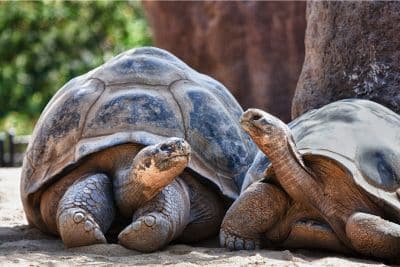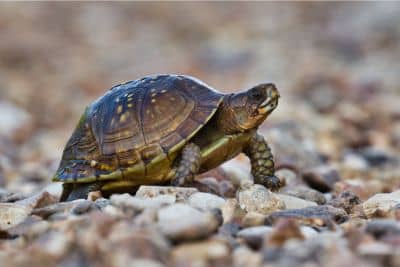Though they’ve long been popular, Hermann’s tortoises (Testudo hermanni) have become even more celebrated among tortoise keepers in recent years.
There are a variety of reasons these tortoises have started attracting so much attention, including their endearing personalities and attractive shell patterns. But perhaps the single most important trait that’s made them a favourite of many is their small size.
By and large, small tortoise species are easier to maintain than large species, so Hermann’s tortoises – who rarely exceed 10 or 11 inches in length – catch the eye of many tortoise enthusiasts.
However, it is important to note that there are two Hermann’s tortoise subspecies, and they reach different sizes. The western Hermann’s tortoise (T. h. hermanni) is the smaller of the two, while the eastern Hermann’s tortoise (T. h. boettgeri) grows quite a bit larger.
In this article, I shall focus on the western subspecies below so you can start deciding if it is the best tortoise species for you.
Geographic Range
The combined range of both Hermann’s tortoise subspecies encompasses a large portion of southern Europe, from Spain to Turkey. However, most of that range is inhabited by the eastern Hermann’s tortoise; the western subspecies is limited to the area stretching between Spain and Italy.
Within this range, Hermann’s tortoises typically prefer open habitats, where basking opportunities and food are plentiful. This includes meadows, grasslands, rocky hillsides, and shrublands. They may also inhabit human-disturbed areas, including suburban lots and agricultural plots.
These animals also inhabit open forests at times.
Appearance and Physical Characteristics: Eastern Vs Western Hermann’s Tortoise
While they are broadly similar-looking, eastern and western Hermann’s tortoises do present a few visual differences.
Both tortoises are relatively small, but while eastern Hermann’s tortoises occasionally reach 11 inches in length, western Hermann’s tortoises rarely exceed 6 or 7 inches in length. Many keepers also note that the western Hermann’s tortoise has a rounder shell than the slightly trapezoidal shell shape displayed by the eastern Hermann’s tortoise.
But it is the shell markings that differ most markedly between the two.
Western Hermann’s tortoises are typically regarded as the more attractive of the two subspecies, as their markings are much better defined and contrast more strongly with the shell base colour. And the ground colour itself differs strikingly – western individuals are typically bold yellow, bordering on orange in some cases. However, eastern Hermann’s tortoises are generally closer to khaki, straw, or tan in colour.
There is also a fairly distinctive marking found on the fifth vertebral scute of western Hermann’s tortoises, which is often likened to a “keyhole” or “mushroom.” This marking is rarely present in Eastern individuals and, when present, is generally not well-defined or symmetrical.
Meanwhile, western Hermann’s tortoises also exhibit distinctive plastral markings too. Specifically, they bear two wide, dark, distinct, irregularly shaped lines that travel down each side of the animal’s plastron. Eastern Hermann’s tortoises may have similar markings, but the borders are not as crisp, nor do they contrast as strikingly with the base colour.
The two subspecies also exhibit differences in head shape and colouration. While eastern Hermann’s tortoises have rounded, nearly bulbous heads with blunt snouts, western Hermann’s tortoises have sleeker, more “refined” looking heads with pointed snouts. Most notably, western Hermann’s tortoises typically have lighter-coloured heads, which feature a bold yellow subocular spot.
Diet
Both Hermann’s tortoise subspecies have similar natural diets. They are almost completely herbivorous animals, though they may consume the occasional insect, slug, or earthworm. Some individuals may also consume carrion from time to time.
Unlike tortoises hailing from rainforests and other tropical areas, who often feed on fleshy fruits, Hermann’s tortoises tend to subsist on foods with more fibre and less water (though they also consume succulents, which have lots of fibre and water). This includes things like grasses, sedges, weeds, and flowers. It is wise to provide a similar diet to captive tortoises.
Behaviour
By and large, western Hermann’s tortoises exhibit similar behaviours to their eastern counterparts. Nevertheless, some keepers have noted slight differences between the two.
- Some keepers feel that western Hermann’s tortoises are less active than eastern Hermann’s tortoises. This, combined with their smaller size, may make members of the western subspecies better suited for keepers with space limitations.
- Many keepers find western Hermann’s tortoises to be more docile and less likely to exhibit signs of stress. However, eastern Hermann’s tortoises are more variable in general, so this trend does not always hold true.
- Western Hermann’s tortoises often hibernate for shorter periods of time than eastern Hermann’s tortoises. However, this tends to vary with the geographic origin of the specific tortoise in question.
- Some keepers find that western Hermann’s tortoises tend to get along better with other tortoises inhabiting the same enclosure. But as with most of these differences, individual personalities vary, even among members of the same subspecies.
Both subspecies tend to exhibit similar breeding behaviours. Mating attempts generally begin shortly after the tortoises emerge from hibernation. Egg laying follows several weeks later, with hatchlings emerging approximately 90 days later.
As with many other tortoise species, the sex of the hatchlings is determined by incubation temperature. At low temperatures, males are produced; at high temperatures, females are produced. When exposed to temperatures in the middle of the acceptable temperature range, a mix of both sexes is produced.
Western Hermann’s Tortoise Stats at a Glance
To make it easier to determine if the western Hermann’s tortoise is the ideal pet for you, we’ll share some key stats about the subspecies below.
- Typical Hatchling Length: 1.5 to 2 inches
- Typical Hatchling Weight: 30 to 50 grams
- Average Adult Length: 5 to 6 inches
- Average Adult Weight: 3 to 4 pounds
- Maximum Adult Length: Approximately 7 inches
- Maximum Adult Weight: Approximately 5 pounds
- Average Annual Fecundity: 1 to 2 eggs, typically deposited in a single clutch
- Recommended Enclosure Size: 8 to 10 square feet of space
- Typical Lifespan: Unclear, but most individuals are likely capable of living for 20 to 50 years, with some individuals potentially living for twice this long. At least two individuals are known to have reached more than 120 years of age.
Citations
- The Links Road Animal & Bird Clinic — May 2023’s Animal Of The Month – Hermann’s Tortoises
- Hermanni Haven – Hermann’s Tortoise Subspecies
- Tortue d’Hermann — Morphology


